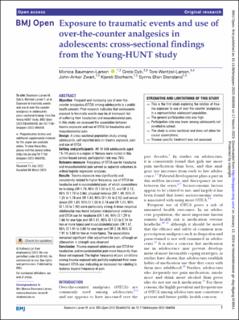| dc.description.abstract | Objective Frequent and increasing use of over-the-
counter analgesics (OTCA) among adolescents is a public
health concern. Prior research indicates that adolescents
exposed to traumatic events may be at increased risk
of suffering from headaches and musculoskeletal pain.
In this study, we assessed the association between
trauma exposure and use of OTCA for headaches and
musculoskeletal pain.
Design A cross-sectional population study among
adolescents, self-reported data on trauma exposure, pain
and use of OTCA.
Setting and participants All 10 608 adolescents aged
13–19 years in a region of Norway were invited in this
school-based survey, participation rate was 76%.
Outcome measure Frequency of OTCA use for headache
and musculoskeletal pain served as separate outcomes in
ordinal logistic regression analyses.
Results Trauma exposure was significantly and
consistently related to higher frequency use of OTCA for
headache and musculoskeletal pain, of which associations
for bullying (OR 1.79, 95% CI 1.50 to 2.12, and OR 2.12,
95% CI 1.70 to 2.66), physical violence (OR 1.49, 95% CI
1.25 to 1.78 and OR 1.83, 95% CI 1.45 to 2.32) and sexual
abuse (OR 1.83, 95% CI 1.55 to 2.18 and OR 1.53, 95%
CI 1.18 to 1.90) were particularly strong. A dose–response
relationship was found between interpersonal violence
and OTCA use for headache (OR 1.46, 95% CI 1.29 to
1.66 for one type and OR 1.81, 95% CI 1.53 to 2.14 for
two or more types) and musculoskeletal pain (OR 1.61,
95% CI 1.91 to 3.00 for one type and OR 2.39, 95% CI
1.91 to 3.00 for two or more types). The associations
remained significant after adjustment for pain, although an
attenuation in strength was observed.
Conclusion Trauma exposed adolescents use OTCA for
headaches and musculoskeletal pain more frequently than
those not exposed. The higher frequency of pain conditions
among trauma exposed only partially explained their more
frequent OTCA use, indicating an increased risk relating to
features beyond frequency of pain. | en_US |

